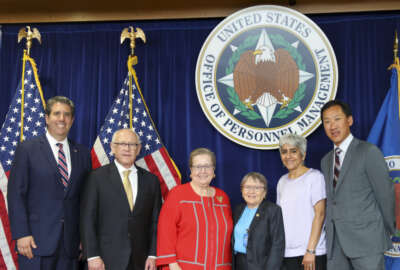3 agencies that improved their FEVS response rates this year — and how they did it
The higher the employee response rate for FEVS, the more accurate the picture that chief human capital officers get into what their workforce both wants and needs.
Each time the Federal Employee Viewpoint Survey comes around, agency leaders use all sorts of strategies to encourage more employees to take time out of their day to respond to the annual litmus test of the federal workforce.
The higher the response rate for FEVS, the more accurate the picture chief human capital officers (CHCOs) get into what their workforce both wants and needs. But for many agencies, it’s challenging to achieve that.
The governmentwide response rate for this year’s FEVS was 39% — a 4% increase over last year’s rate — according to the 2023 results the Office of Personnel Management published in November.
Generally, many CHCOs have found that creating a solid feedback loop with employees is one path toward a better response rate, Veronica Hinton, OPM’s associate director for workforce policy and innovation, said at the CHCO Council’s Dec. 12 annual public meeting.
“When employees believe FEVS results will be used, response rates tend to trend higher,” Hinton said. “It’s a momentum we want to carry forward as we continue our action planning with 2023 results and start to plan for the 2024 survey.”
The feedback loop is critical, Hinton said — that means sharing survey results with employees and being transparent about what changed in response to employees’ feedback.

For some agencies, maintaining the feedback loop is difficult. Most years, the FEVS question “I believe the results of this survey will be used to make my agency a better place to work” is one of the lowest-scored items from employees governmentwide.
For 2023, FEVS saw a 5% jump in those who agreed with the statement, but it was still less than half of FEVS respondents who felt positively about it.
Several CHCOs during the council meeting Tuesday offered promising practices and shared where their own agencies were seeing internal improvements.
Department of Housing and Urban Development
The Department of Housing and Urban Development, notably, had 71% of its employees respond to the 2023 FEVS this past spring. It’s significantly above the 39% governmentwide average, but the high level of response wasn’t without major efforts from the department, said Lori Michalski, HUD’s chief human capital officer.
“One of the areas that we really focus on is the ‘I believe’ — that I believe the results of this survey really are going to make a difference,” Michalski said during the CHCO Council meeting. “That’s what we’ve really been building on for the last few years.”
Michalski added that she views FEVS scores not as numbers, but as “impact indicators.”
“Are we doing the right things that are moving us in the right direction, and really telling that story to our employees?” Michalski said. “We identify focus areas where we could actually focus on that impact, and then share those results with our employees.”
For instance, HUD saw a pattern in its FEVS results over the last few years of employees’ concerns over wellness. Many were calling for more wellness-improving activities at work. In response, HUD launched a “wellness corner” to offer some of those opportunities to employees.
To then close the feedback loop, “we shared that success and those impacts of the voices that we heard with all of our employees,” Michalski said.
Department of Interior
At the Department of Interior, one of the biggest barriers to improving response rates for FEVS is the vast geographic dispersion of the workforce, Mark Green, the agency’s chief human capital officer, said during the CHCO Council meeting.
“We have about 70,000 employees throughout the country … many people are in these rural and remote communities and areas,” Green said. “We have many of our folks deliver their work in office settings, but we have a large part of our workforce that goes out in the field [and] out on the land every day. They’re not really in office, so that brings challenges.”
Green said using a FEVS communication guide from OPM helped Interior supervisors and managers figure out a communication strategy to spread the word and encourage employees to take the survey. The department also set up a webpage to offer information about FEVS to employees and create a clear message of why taking the survey was important.
Additionally, Interior Secretary Deb Haaland “really takes the FEVS results seriously,” Green said. “That senior leader emphasis cascaded down through all leaders — from her level, all the way down to our first line supervisors, to ensure that the expectation was clear. We would have our leaders at every level make sure that employees had the opportunity to take the FEVS.”
To try to boost participation, the department also set up an incentive for employees to take the survey this year. Any Interior bureau or office that was able to increase participation in FEVS received an additional two hours of administrative leave as a reward.
The efforts paid significant dividends. Interior got a 64% response rate in the 2023 FEVS, a massive jump from the department’s 47% response rate in 2022. Interior also saw both its engagement and satisfaction scores increase by 2% each since last year.
Department of Homeland Security
Historically, the Department of Homeland Security has ranked at or near the bottom of the Partnership for Public Service’s Best Places to Work list each year. But signs from the 2023 FEVS results point in a more promising direction.
Many of the department’s FEVS scores increased by record levels this year. For 2023, DHS employees’ engagement increased by three points, from 64% to 67% in the last year. For job satisfaction, DHS’s scores jumped up by six points — three times the governmentwide average increase for 2023.
Roland Edwards, chief human capital officer at DHS, said the major improvements did not happen just by chance.
“One of the biggest things that our leadership has told us is that we can’t sit back and admire the problem,” Edwards said during the CHCO Council meeting. “This has been established as a priority for every DHS leader.”
In addition to the more positive results, DHS’ response rate jumped from 36% to 44% between 2022 and 2023.
Speaking directly to employees, often by conducting focus groups, has been a high priority over the last year, Edwards said. Beyond FEVS, the department conducts smaller pulse surveys throughout the year to get more up-to-date feedback from employees.
Edwards’ team also created a clear, three-part framework to try to address the needs of department employees: basic needs, confidence and recognition.
“How are we ensuring that the guidance and communications that we’re putting out to our employees resonate, and they are getting clear direction?” Edwards said. “And then how are we recognizing our employees for a job well done for a really dedicated, hardworking workforce?”
Perhaps most notably, one effort that Edwards said he’s especially proud of is DHS’s new “jump teams.” The teams, composed of experts across headquarters and component offices, visit DHS field locations across the country to hear about and try to resolve specific issues in resources, IT, management, facilities and more.
“Oftentimes, these are things that could be longstanding. Sometimes, they are simple resolutions, sometimes they’re a little bit more long-term and they require more effort to fix. But that’s been amazingly helpful,” Edwards said.
Copyright © 2025 Federal News Network. All rights reserved. This website is not intended for users located within the European Economic Area.
Drew Friedman is a workforce, pay and benefits reporter for Federal News Network.
Follow @dfriedmanWFED






